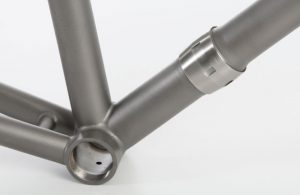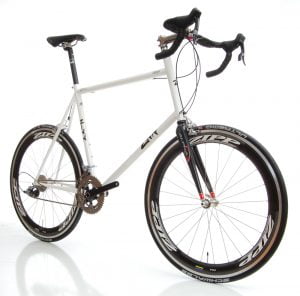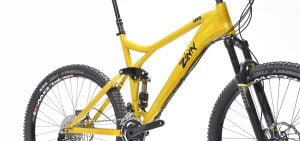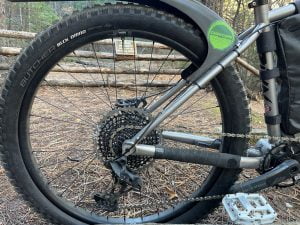Are you building a custom bicycle from the frame up? Building your bike can be a rewarding experience for enthusiastic cyclers. Doing it yourself gives you complete control over the components you choose to create your masterpiece. Knowing how to pick the correct frameset and bike components will allow you to build a bike that’s tailor-made just for you. Today we will cover all you need to know when considering wheels for custom bikes for big and tall riders.
Building a custom bike from the frame up is a different experience than buying a pre-made bike from a manufacturer. It’s like going to a high-end clothing store and having a tailor take your measurements and create an article of clothing made specifically for your body dimensions and personal style. As you can imagine, the results would be more comfort, better performance, and a higher sense of satisfaction. The same idea applies to a custom-made bicycle. You get to make the final decision on every aspect of your bike. What color you want your frame to be, the exact components you want to install, etc. You get to optimize each part to get the results you desire.
4 Key Components Needed To Build A Custom Bike
#1 – Sturdy Frame

A sturdy frame is the most vital component when building a custom bicycle. Frames are by far the most expensive part of the bike and come in different levels of quality. You can choose a titanium, magnesium, or steel frame. Just make sure you pick a frame designed for the terrain you plan to ride on. During your selection process, be sure the frame fits your body specifications. If the frame is too large or too small, it will affect the level of comfort, safety, and the amount of pain you may experience in your neck, knees, and lower back.
#2 – Durable Forks

The second key component is the fork. Your fork will be connected to the handlebars to steer the bike and the front wheel. You have the choice of a rigid fork or suspension fork. The three main dimensions you need to pay attention to are the steerer tube length, fork leg length, and rake. If you’re looking to ride in a more upright position, you’ll need a longer steerer tube. The fork length is the distance from the crown of the steering tube to the axle on the front wheel. The rake is the distance from the axle to the rim of the front wheel. All three of these dimensions will affect the handling of the bike.
#3 – Bike Crankset

The bike crankset is the drivetrain for your bicycle. Cranksets allow the rider to pedal to propel the bike into motion. The chain is connected to the crank and turns the back wheel. Choosing the wrong crankset can reduce performance and may increase discomfort. We suggest using proportional length cranks for optimum results.
#4 – Strong Bicycle Wheels

Strong bicycle wheels will give your custom bike more durability and provide better power transfer for heavier riders or those carrying gear, especially when climbing hills. The level of strength correlates directly to the number of spokes on the wheel. The higher the number of spokes, the higher the likelihood you have a strong bicycle wheel. Spoke count is critical, but it’s not the only factor you should consider.
The stiffness of the rim and the thickness of the wall matter as well. Stiffer bicycle rims and thicker walls work together with the spokes to make a bicycle wheel stronger. For bigger and taller riders, this is especially important.
At Zinn Cycles, most of our customers are taller than 6’4″ and weigh well over 200 pounds. We build wheels for big riders every day, be they 700C road, gravel, and cyclocross wheels, 29er (including 29+) mountain bike wheels, 36er wheels, and 32er wheels. The quality of the build is critical. The rim, hubs, spokes, and spoke count must be chosen appropriately for the rider.
Here is a list of our main criteria for building strong bicycle wheels.
- High spoke counts
- Double-butted spokes
- Spoke-bracing angle
- Rim stiffness
- Rim strength
- Thread locked nipples
- Spoke holes further from the edge of the hub flange
- Robust freehub
- Through axles
How To Select Bicycle Wheel Components
Rims
Starting from the outside and working inward, stiff, strong rims are extremely important for big riders. Rims and spokes work together to create the dynamic structure of the wheel. Stiff rims and higher spoke counts give the rider a much sturdier ride, while fewer spokes will lessen the tension as a wheel rolls along. A taller cross-section makes a rim stiffer, and greater wall thickness, coupled with a good choice of alloy, makes it stronger. For instance, the Velocity Chukker rim has a deep, V-shaped cross-section combined with a thick wall and a strong alloy, and for this reason, it is often our choice for a road or gravel wheel for a big rider.
Hub strength
The hub has to be strong, have stiff hub shells, strong flanges, a robust freehub, drilled for high spoke count, wide bracing angles on the spokes, and a through-axle. Big guys pedaling hard in low gear can twist the rear hub shell, as can disc brakes applied too hard under heavy load and high speed, so a stiff hub shell is a no-brainer for strong bicycle wheels.
Through-axle hubs strengthen both the wheel and the frame and fork and are a must-have for heavy riders. They are built with holes and not slots and come with threaded nuts integrated into them and can come in 12mm, 15mm, or 20mm upfront and 12mm in the rear. If you have quick-release dropouts, you can still use a 10mm through axle in the rear rim and a 9mm in the front. These hubs have nuts on the ends instead of a hollow axle with a quick-release skewer inside. A 9mm or 10mm through-axle will fill the entire space of the dropout and provide much better dropout support.
The front and rear ends of the bike will track better because of the stiff axles tying the fork legs and rear end together. Full-suspension bikes have outer fork legs that slide smoothly over the inner legs and the rear swingarm members to track without a wobble. Also, the rear through-axle will prevent the hogging out of the right rear dropout that can happen, particularly on mountain bikes, with a big, strong rider putting out high torque in low gear. If your rear wheel keeps pulling over the left chainstay, there may be an issue with your dropout. You can expect this to occur no matter how tight you keep your quick-release skewer.
Spokes
At Zinn Cycles, we use higher spoke counts, aiming for around 36, with high-quality, double-butted 2.0/1.8mm (14/15-gauge) stainless steel spokes with brass thread-locked nipples to prevent them from loosening up, and DT Competition spokes with DT Pro Lock nipples.
Contrary to what you might think, the lighter, stretchier, double-butted spokes make for a longer-lasting wheel than a heavier, straight-gauge 2.0mm (14-gauge) spokes of the same quality. As the spokes stretch, they move some stress concentration from the weakest points at the elbow and nipple, allowing the nipples to stay in contact with the rim under high wheel deformations (often occurring under somebody big), reducing rim fatigue..
An obvious wear factor on a wheel is impact — a guy who unweights the bike for train tracks or potholes will lessen the amount of impact damage compared to the guy who bangs into everything fully weighted on the saddle. And, of course, the greater the weight (force) on the wheel on impact, the greater the damage it will sustain.
But often, fatigue comes into play more so than impacts when it comes to wheel durability. Fatigue is dependent on weight and the smoothness of the pedal stroke. At least half of the customers buying bikes or cranks from Zinn Cycles and Clydesdale Bicycles are over 250 pounds, and the ones with a hitch in their pedal stroke crack rear rims on factory-built wheels at every drive-side spoke nipple in short order. We have some 300-pound customers who get good wheel wear and others who break everything in no time; they break hub flanges and spokes, crack rims, and pull apart two-piece press-fit hubs.
The spokes loosen up because, as the wheel rolls, the section at the bottom becomes flattened (D-shaped). If the rider is heavier, that flat spot is deep enough to de-tension the spoke at the bottom because the nipple has lost contact with the rim. Lost nipple contact allows each spoke to jiggle when it hits the bottom of the rotation. Consequently, they will unscrew gradually over time.
Furthermore, as the wheel continues rolling, the flattened section of the rim snaps back to its original shape, abruptly bringing that spoke that had been at the bottom back to full tension. If the spoke had been completely de-tensioned, the bang-bang-bang of the impact of the rim snapping back against the nipple with every single wheel rotation fatigues not only the spoke but also the rim at that spoke nipple. This continual action causes the rim to crack at each nipple when used regularly.
Rim cracking at each nipple is a big issue with aluminum spokes. The reason for this is that aluminum has less elasticity. An aluminum spoke is not stretched as much as thinner steel spokes. So it decreases the likelihood of deformation at the bottom when the nipple loses contact with the rim. Thus, aluminum spokes require less load on the wheel for that bang-bang-bang process to crack the rim when compared to steel spokes.
That is why double-butted steel spokes will result in longer life of both the rim and the spoke compared to straight-gauge steel spokes. You can expect better durability because the thinner center section will stretch more at the overall spoke tension. This keeps the nipple in contact with the rim better as it rolls, and its thicker ends will still protect it where the stress is most concentrated.
While higher spoke tension will not make the wheel stronger or laterally stiffer, it is usually necessary to use a higher spoke tension with larger-sized riders. Higher spoke tension helps to avoid the deformation of the wheel while rolling that can cause the bottom spoke to become completely de-tensioned and lead to nipple loosening and rim and spoke fatigue. Wheel lifetime is longer with more uniform spoke tension, and a professional wheelbuilder with a lot of experience can give you the strong bicycle wheels you need.
32-inch Wheels and 36-inch wheels
32-inch wheels and 36-inch wheels don’t fall into 29-inch holes. They smooth out the terrain, have tremendous gyroscopic stability, and roll fast. Wheels for a 32er or 36er are taller, and the spoke bracing angle is significantly lower. In other words, the longer spokes coming off of standard-width hubs end up being closer to parallel to the central plane of the wheel. With this design, spokes are less able to oppose the side-loading of the wheel. The solution? Wider hubs! On our 32ers and 36ers, we use a 150mm front hub and a 157mm rear hub. Going wide is the perfect solution and gives the spokes ample angles from the hub flanges to oppose side loads.
When building a custom bike, you have the option to have strong bicycle wheels custom-made for you, or you can use the criteria mentioned above to help you make your decision.
Why Choose Zinn Cycles
Zinn Cycles has served cyclists in the United States, Canada, UK, Europe, Australia and New Zealand for 40+ years. Instead of building a custom bicycle on your own, let the experts do it and save you the stress. We specialize in custom-made bikes and bike parts designed for big, tall, short, or small riders. You can count on us to provide you with a bike that’s superior in quality and designed to your specifications. We have experts ready to help, so schedule a call or email us today at [email protected]. Let the professionals do the heavy lifting for you and save you a lot of time and effort.


